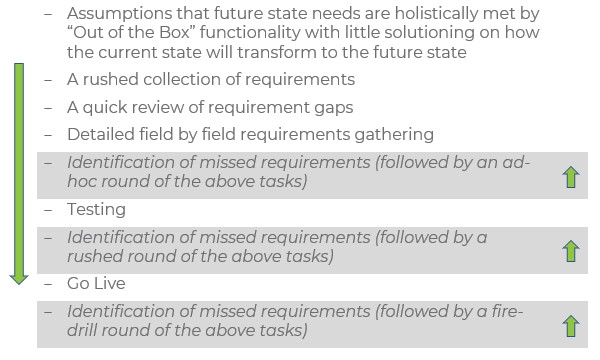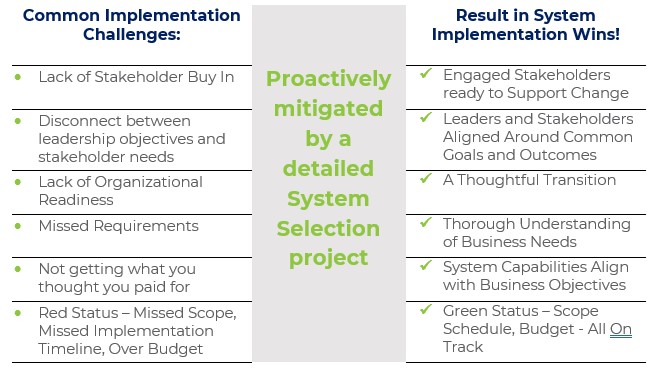Hint: It’s not just selecting the system
There aren’t many events more stressful than a system implementation project in red status. In part 1 of this series we looked at System Implementation challenges through the “Tale of 1EasyTool”. Now, in part 2, we’ll explore how 6 common implementation challenges, when proactively mitigated by a detailed system selection project, result in system implementation wins!
How a Detailed System Selection Project Proactively Mitigates System Implementation Challenges
While a detailed System Selection project does not guarantee a good implementation experience, it is one of the best tools to ensure your organization starts system implementation on a solid foundation. Here is an explanation of how a detailed System Selection project mitigates some of the most commonly encountered System Implementation challenges and can set your organization up for success.
1. Engaged Stakeholders Ready to Support Change
One of the biggest advantages to performing a detailed System Selection project is early stakeholder engagement. When done correctly, stakeholders are introduced to the business case early and given many opportunities to provide detailed input on the system selection. Their detailed input is thoroughly assessed by vendors to gauge software fit and represented to executive leadership via vendor demo scores. The business needs of stakeholders are elevated to be a primary determining factor for system selection and the result is stakeholder buy-in.
2. Leaders and Stakeholders Aligned Around Common Goals and Outcomes
A detailed System Selection project provides a significant benefit to organizational leaders who gain:
- A platform to systematically prioritize and communicate company priorities
- A deeper understanding of end-to-end operations and organizational challenges (with stakeholder input)
- Confidence and wisdom in decision making (system implementation is expensive, can strategically shape the organization, and can help or hurt a leader’s reputation)
When done correctly, the process provides organizational leaders with an opportunity to deepen relationships and build trust with employees, acknowledging business needs across the organization and performing appropriate requirement prioritization. With this approach, if the system selected by leadership is not the system recommended by stakeholders, productive and factual conversations can be held on organizational strategy and how to address operational challenges. The selection decision won’t be made in a vacuum, and leaders throughout the organization will be fully aware of the pros and cons of the selected system.
3. A Thoughtful Transition
A detailed System Selection project organically supports organizational readiness. When stakeholders participate in live interactive demos on how their department specific requirements may be accomplished in the future state, they begin learning what to expect. Stakeholders gain familiarity and can begin to visualize the benefits and challenges that the tool will bring to the organization. Further, as the project progresses (during selection or implementation) stakeholders will pull in their colleagues creating greater company awareness of the upcoming initiative.
Deliverables from a detailed System Selection project can also be used to proactively drive organizational readiness.
- How big of a change will this be for the organization?
- Is there enthusiasm or resistance to the forecasted changes?
- How much training and communication will be required?
- What resources do we need to ensure a smooth transition to future state?
By understanding the current state of operations, future state requirements, and how operations may need to change with the system implementation, you will be equipped to forecast organizational readiness needs and thoughtfully transition to a new way of working.
4. Thorough Understanding of Business Needs
A detailed System Selection project involves requirement gathering from across the organization and is a major tool to mitigate missed requirements which can have costly impacts during system Implementation.
A recommended approach to mitigate missed requirements involves early identification of high and medium level requirements during the detailed System Selection project followed by an overall review and the addition of low level (field) requirements during system implementation.
Unofficially, between System Selection and System Implementation, stakeholders have an opportunity to think of anything that may have been missed and then during System Implementation there is a deeper assessment of requirements.
In cases where a detailed System Selection project is skipped, all the requirements gathering steps must still be done. In reality, the process that frequently takes place when a detailed System Selection project is skipped involves:

Ultimately investing in a thorough requirements gathering approach during a detailed System Selection project saves time and increases quality. When started early on, you gain added benefits:
- Time saved during system implementation one for one
- Early identification of requirements gaps helps to select the best system for your organization and minimize costly customizations and workarounds incurred when the wrong system is selected
- Fewer contracted resources are involved in high and medium level requirements gathering during system selection than will be in system implementation, so a cost savings is realized with this approach
- Iterative requirements review provides stakeholders multiple opportunities to speak up and decreases the chance of missed requirements (where iterations are likely spaced apart by a month or more)
- Requirements gathering is not rushed or distracted by pressure to build the solution
- Overall project quality increases and there is a thorough understanding of business needs
5. System Capabilities Align with Business Objectives
Vendor led demos are almost always impressive and showcase a broad view of possibilities along with pretty conveniences (bells and whistles). Vendor led quotes then follow up proposing add-ons that you don’t comprehend, and quick assumptions on licensing and support needs. If a system is selected and purchased based on the quick demos and quick quoting process the result will likely be that you’re not getting what you thought you paid for while paying for features you don’t need. Worst of all, making the correction could incur a significant increase in your annual license costs.
While neither the vendor led demos or vendor led quotes are bad, they can be a distraction. Investing in a detailed System Selection project educates you and the vendor on exactly what features and licenses your organization needs – up front. By holding client-led interactive vendor demos you gain an understanding of what is quoted and what is needed. Then, you can ensure quoted system capabilities align with business objectives and pricing by line item is transparent.
6. Green Status – Scope, Schedule, Budget – All on Track
When a detailed System Selection project is skipped, implementation vendors have to rely on high level knowledge rather than detailed facts to estimate their implementation timeline and cost. Similarly, the organization will lack the knowledge needed to properly estimate the level of effort required from internal resources. Then a few months down the road, the executive team will learn of the missed facts and wrong assumptions, when the project status turns Red, and they have no option but to extend the timeline and approve more budget.
A detailed analysis of overall scope and requirements during System Selection enables implementation vendors to accurately forecast an implementation timeline. This same detail enables your organization to estimate the required level of effort from stakeholders, the project management team, and potentially additional contractors. This is your best tool to mitigate budget and timeline overages.
Discussions on the vendor’s implementation approach with a proposed timeline should begin during the System Selection RFP and then be refined and reviewed in depth before the final system selection. During the final reviews, the implementation vendor should provide guidance on internal resource needs. Your result will be a realistic timeline and budget (but you should still set aside some contingency).
You’ve likely encountered some of the most common implementation challenges and know how costly they can be. By mitigating challenges with a detailed System Selection project, you’ll quickly gain a return on investment during System Implementation.

Prevention of costly and painful implementation challenges makes it easy to see why the true value of a detailed System Selection project is realized during system implementation.
If you’re still unsure whether you need to conduct a detailed System Selection project, the upcoming article is for you! In Part 3, we’ll look at ten indicators to help you determine whether you should conduct a detailed System Selection project. If you are seeking this knowledge now, reach out to us.



